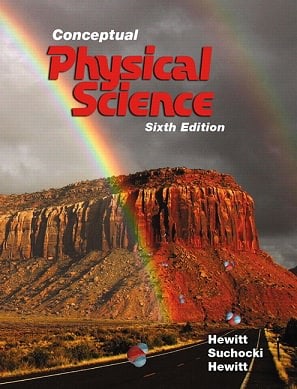 By: Paul G. Hewitt; John A. Suchocki; Leslie A. Hewitt
By: Paul G. Hewitt; John A. Suchocki; Leslie A. Hewitt
Edition: 6th
Year: 2017
For one- or two-semester physical science survey courses for non-science majors. Opening the Doors of Science Conceptual Physical Science, Sixth Edition, provides a conceptual overview of basic, essential topics in physics, chemistry, earth science, and astronomy with optional quantitative analyses. The authors focus on concepts before computations. With its clear, friendly writing style, and strong integration of the sciences, this book connects well with all students.
Part One: Physics
Chapter 1: Patterns of Motion and Equilibrium
1.1 Aristotle on Motion
1.2 Galileo’s Concept of Inertia
1.3 Mass—A Measure of Inertia
1.4 Net Force
1.5 The Equilibrium Rule
1.6 Support Force
1.7 The Force of Friction
1.8 Speed and Velocity
1.9 Acceleration
Chapter 2: Newton’s Laws of Motion
2.1 Newton’s First Law of Motion
2.2 Newton’s Second Law of Motion
2.3 Forces and Interactions
2.4 Newton’s Third Law of Motion
2.5 Summary of Newton’s Three Laws
Chapter 3: Momentum and Energy
3.1 Momentum and Impulse
3.2 Impulse Changes Momentum
3.3 Conservation of Momentum
3.4 Energy and Work
3.5 Work–Energy Theorem
3.6 Conservation of Energy
3.7 Machines
3.8 Efficiency
3.9 Sources of Energy
Chapter 4: Gravity, Projectiles, and Satellites
4.1 The Universal Law of Gravity
4.2 Gravity and Distance: The Inverse-Square Law
4.3 Weight and Weightlessness
4.4 Universal Gravitation
4.5 Projectile Motion
4.6 Fast-Moving Projectiles—Satellites
4.7 Circular Satellite Orbits
4.8 Elliptical Orbits
4.9 Escape Speed
Chapter 5: Fluid Mechanics
5.1 Density
5.2 Pressure
5.3 Buoyancy in a Liquid
5.4 Archimedes’ Principle
5.5 Pressure in a Gas
5.6 Atmospheric Pressure
5.7 Pascal’s Principle
5.8 Buoyancy in a Gas
5.9 Bernoulli’s Principle
Chapter 6: Thermal Energy and Thermodynamics
6.1 Temperature
6.2 Absolute Zero
6.3 Heat
6.4 Quantity of Heat
6.5 The Laws of Thermodynamics
6.6 Entropy
6.7 Specific Heat Capacity
6.8 Thermal Expansion
6.9 Expansion of Water
Chapter 7: Heat Transfer and Change of Phase
7.1 Conduction
7.2 Convection
7.3 Radiation
7.4 Newton’s Law of Cooling
7.5 Climate Change and the Greenhouse Effect
7.6 Heat Transfer and Change of Phase
7.7 Boiling
7.8 Melting and Freezing
7.9 Energy and Change of Phase
Chapter 8: Static and Current Electricity
8.1 Electric Charge
8.2 Coulomb’s Law
8.3 Electric Field
8.4 Electric Potential
8.5 Voltage Sources
8.6 Electric Current
8.7 Electrical Resistance
8.8 Ohm’s Law
8.9 Electric Circuits
8.10 Electric Power
Chapter 9: Magnetism and Electromagnetic Induction
9.1 Magnetic Poles
9.2 Magnetic Fields
9.3 Magnetic Domains
9.4 Electric Currents and Magnetic Fields
9.5 Magnetic Forces on Moving Charges
9.6 Electromagnetic Induction
9.7 Generators and Alternating Current
9.8 Power Production
9.9 The Transformer— Boosting or Lowering Voltage
9.10 Field Induction
Chapter 10: Waves and Sound
10.1 Vibrations and Waves
10.2 Wave Motion
10.3 Transverse and Longitudinal Waves
10.4 Sound Waves
10.5 Reflection and Refraction of Sound
10.6 Forced Vibrations and Resonance
10.7 Interference
10.8 Doppler Effect
10.9 Bow Waves and the Sonic Boom
10.10 Musical Sounds
Chapter 11: Light
11.1 Electromagnetic Spectrum
11.2 Transparent and Opaque Materials
11.3 Reflection
11.4 Refraction
11.5 Color
11.6 Dispersion
11.7 Polarization